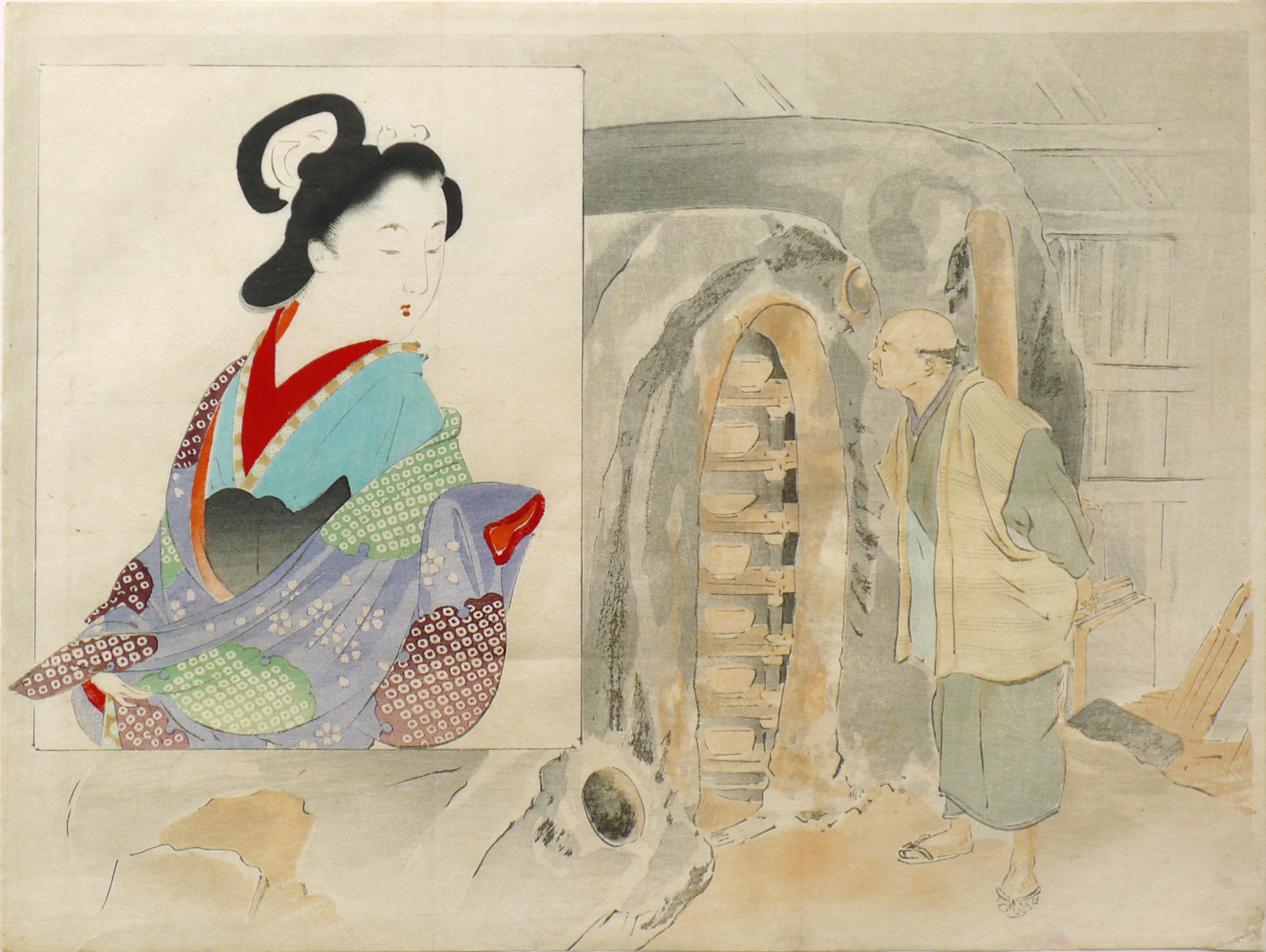About This Print
This print was the frontispiece for volume 6, no. 1 of the literary magazine Bungei Kurabu (Literary Arts Club), published in Meiji 34th year (1901) which featured the story Wankyu Monogatari. In this scene, a potter inspects a full Noborigama kiln. An inset shows an elegant bijin in the style of the Muromachi period. Written in 1685, Wankyu Monogatari is the story of a wealthy merchant Wankyo Kyuemon and his love for the courtesan Matsuyama which leads to madness and death.Update Aug. 23, 2017
Further research indicates that the story this print illustrated in Bungei Kurabu was a later-day version of the story Wankyu Monogatari, by the writer Kōda Rohan titled Kyūbei the Potter, a synopsis of which follows.
Source: Kōda Rohan, Chieko Irie Mulhern, Twayne Publishers, 1977, p. 127.
[The story's] main characters are a potter and a courtesan whose love affair and involvement in "trade espionage: occurred actually in the 1650s. A Kyoto potter Kyūbei begins to seek the favors of a courtesan Matsuyama, after he learns that her father is a debt collector from the Kyushu potters'guild, whose secret of gold-painted porcelain is jealously guarded. Through the help of Matsuyama, he finally induces her unsuspecting father to confide the secret. Kyubei succeeds in producing a new porcelain even superior to the Kyushu products, but loses his mind after Matsuyama's fathher is executed for revealing the trade secret inadvertently. He recovers later, eventually to settle down to a happy married life with Matsuyama.
The Literary Magazine Bungei Kurabu
Bungei Kurabu 文芸倶楽部 was a very popular literary magazine published from 1895-1933 by Hakubunkan. It was one of the most dominant venues for Meiji literature, publishing noted authors such as Izumi Kyôka, Kunikida Doppo, Higuchi Ichyô, and Kawakami Bizan. In the magazine's later years, post 1907, it became a less elevated popular entertainment magazine.Print Details
| IHL Catalog | #532 |
| Title | Wankyu Monogatari 椀久物語 |
| Series | frontispiece from Bungei Kurabu 文藝倶楽部 vol.6, no.1. |
| Artist | Takeuchi Keishū (1861-1942) |
| Signature | not signed |
| Seal | not sealed (some impressions carry the rectangular Keishu seal as can be seen on the kuchi-e After the Bath.) |
| Publication Date | 1900 |
| Publisher | Hakubunkan (publisher of Bungei Kurabu) |
| Printer | likely Yoshida Ishimatsu (1866-1924)1 |
| Impression | excellent |
| Colors | excellent |
| Condition | excellent - minor loss right corner and residue verso right margin where removed from magazine; two flattened vertical folds resulting from the manner in which this frontispiece was inserted in the publication |
| Genre | ukiyoe, kuchi-e |
| Miscellaneous | |
| Format | |
| H x W Paper | 8 5/8 x 11 1/2 in. (21.9 x 29.2 cm) |
| Collections This Print | |
| Reference Literature |
1 According to Merritt in Woodblock Kuchi-e Prints: Reflections of Meiji Culture (p. 11-12), Keishu hired Ichimatsu at Hakubnkan where he printed kuchi-e and became the head printer until the magazine stopped issuing color woodblock prints.


